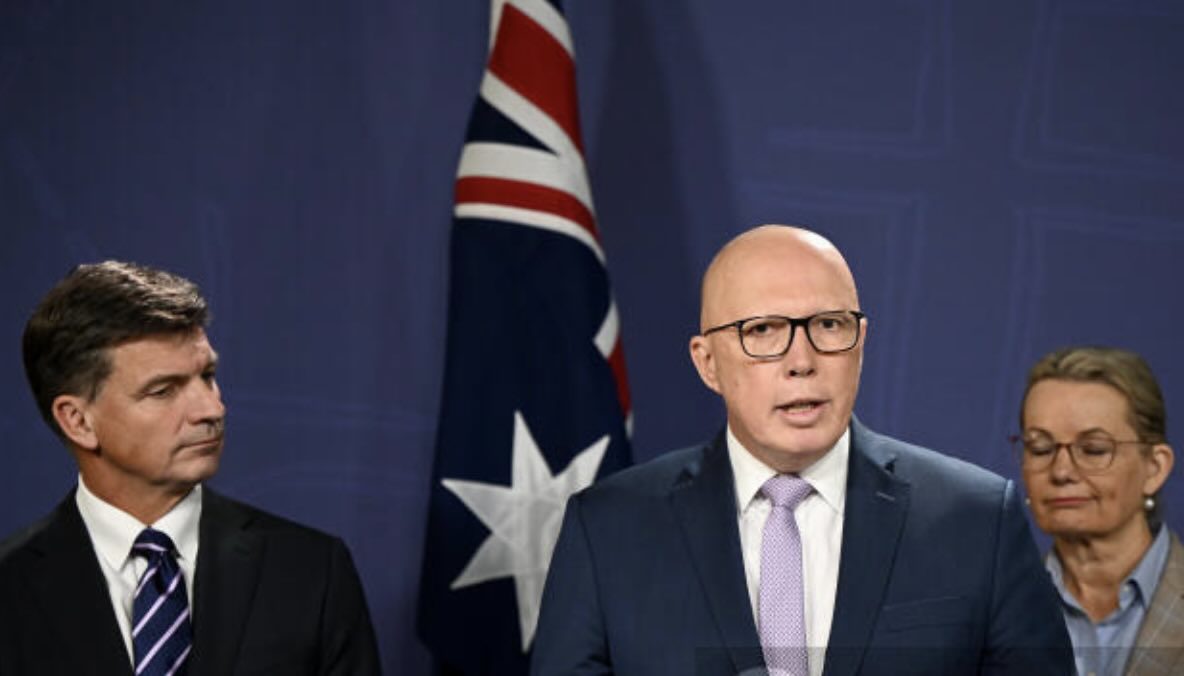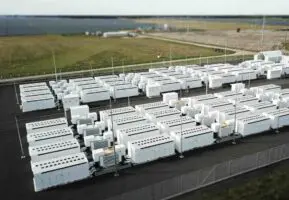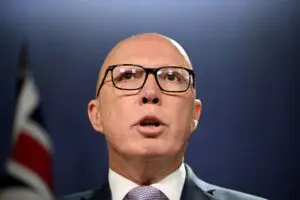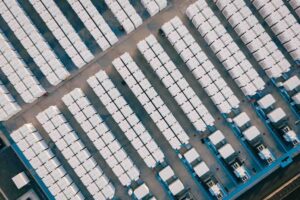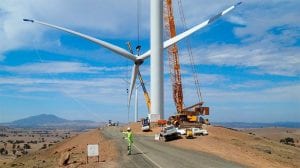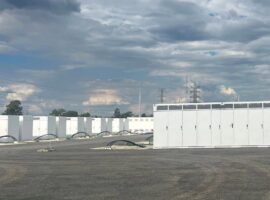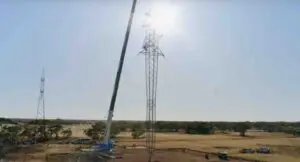So, here it is, finally, the Coalition’s nuclear policy – a massive and dangerous boondoggle to build expensive nuclear power plants that presents a serious threat to Australia’s renewable energy transition, and the country’s economic future.
It’s a policy that is all about power, not so much on the grid as to what flows through the corridors of parliament house and in the channels of mainstream and social media.
And amid all the insults about the stupidity, the impracticality, and moral vacuum of the plan, energy minister Chris Bowen probably best summed it up: “It’s a joke, but a serious joke because it threatens the renewable transition.”
And that much is true. It’s what the policy is designed to do. It may make no sense, but it is designed to be deliberately populist and has been enthusiastically supported by the Murdochs and the fossil fuel industry.
As noted in this article, the plan outlined by opposition leader Peter Dutton is broadly this: Build seven nuclear plants at the sites of existing or shuttered coal fired power stations. There will be small modular reactors in South Australia and Western Australia (at Port Augusta and Collie), and the Coalition laughingly believes this can be done by 2035, even though SMRs don’t yet exist, federal and state law prohibits it, and there is no regulatory infrastructure.
Big nuclear – huge plants up to 1.4 gigawatts (GW) – are proposed for Victoria (Loy Yang), NSW (Liddell in the Hunter Valley and Mt Piper near Lithgow) and Queensland (Tarong and Callide).
The plan has already been dubbed as the latest Coalkeeper, because that is essentially what it is. Should the Coalition win power, it means coal fired power stations will be kept open, and investment in new large scale renewable and storage projects will be killed. Contracts will even be ripped up.
But it will do more than stop wind and solar. It will result in more fossil fuels in the form of gas fired power stations, cripple investment in new green industries and exports, and cause Australia to tear up its part of the Paris climate agreement.
In short, it would deliver everything that the coal lobby and climate deniers have been pushing for over the last few decades.
“I’m not interested in lining the pockets of rich green millionaires,” said Dutton, who infamously flew across the country to wish happy birthday for an hour to Australia’s richest person, the mining billionaire and arch renewables critic Gina Rinehart.
About the only part of the Coalition plan that follows any sort of logic is the fact that it would use the federal government-owned Snowy Hydro as the vehicle to build nuclear. It is not surprising. Renew Economy has been suggesting this would be the case for months, because no private investor will go anywhere near nuclear power.
The farcical Snowy 2.0 pumped hydro scheme provides a precedence for vast, ill conceived projects that run hugely over budget and with massive delays, and which crowd out other investment – which nuclear will inevitably do.
And because it will be entirely taxpayer funded, the true cost can be hidden from consumer energy bills. And just as the government waved away the massive spend on nuclear subs, so it will do for these generators. Together, they will amount to more than half a trillion dollars – that’s a lot of schools, hospitals, houses, solar panels and energy efficient appliances.
Government funding will also have to come for insurance, because once again no private insurer will go near nuclear, and that insurance will likely have to cover homes and businesses nearby, because no private insurer is prepared to cover those risks, either.
The sites chosen are predictable. It’s where coal fired power stations operate, or have recently been closed. They have strong transmission links, and local communities. But the sites also have significant problems.
For a start, the Coalition has chosen Port Augusta in South Australia, where the last coal fired power station closed in 2016, and Collie in Western Australia, where units are already being closed and where the last coal generator will close by the end of the decade.
In both states the output of rooftop solar has already, or will soon, reach levels that equal all local demand, squeezing out gas and even other renewable generators.
By the early 2040s, there will be four times as much rooftop solar in those states – so how exactly does the Coalition believe it can jam nuclear into a grid which needs no new power in the day. It’s complete lunacy and energy illiteracy.
These sites are also likely to have their transmission capacities well used by the 2040s, or even the mid 2030s. There are already numerous very big wind, solar, battery projects at Port Augusta, and the transmission capacity in Collie will be largely swallowed by two of the country’s biggest battery storage projects already under construction.
As South Australia energy minister Tom Koutsantonis noted on Wednesday: “The myth that a nuclear reactor could just plug into the old Pt Augusta coal power station transmission lines is not true. The transmission lines are already nearly full from new renewables. In truth, a nuclear reactor at Pt Augusta would need new transmission lines.”
The same applies to the other sites targeted by the Coalition – in the Latrobe Valley, at AGL’s Liddell coal site in the Hunter Valley and EnergyAustralia’s Mt Piper coal site west of Lithgow. All these companies have detailed plans for solar, battery storage or even pumped hydro.
Damien Nicks, the boss of AGL which has two sites targeted by the Coalition – Liddell and Loy Yang – has repeatedly said nuclear forms no part of its plans, and that it wants to create new clean energy and industrial hubs. “As the owner of these sites, nuclear energy is not a part of these plans,” he said in March.
On Wednesday, it reissued that statement. “There is no viable schedule for the regulation or development of nuclear energy in Australia, and the cost, build time and public opinion are all prohibitive,” Nicks said.
“Policy certainty is important for companies like AGL and ongoing debate on the matter runs the risk of unnecessarily complicating the long-term investment decisions necessary for the energy transition.”
Does the Coalition intend to curtail or prevent this private investment? It certainly sounds like it, and in government it does have form on this – having threatened one of Nicks’ predecessors, the American Andy Vesey, when he dared to announce the closure of Liddell, and all but chasing him out of the country.
EnergyAustralia is the other major private player targeted by the Coalition. Its parent, the Hong Kong-based CLP, has nuclear interests in China.
In a statement, an EA spokesperson told RenewEconomy no one had talked to it about the Mt Piper facility, where it has previously announced plans for a big battery, a pumped hydro facility and nearby renewables.
“Beyond our focus on deploying available technologies, there is much still to do in the energy transition in the 2030s and beyond. EnergyAustralia is technology neutral as to what will be required. Nuclear is recognised internationally as a zero carbon energy generation technology, one that needs a good regulatory framework and a well developed industry to deliver support it.
“We regularly talk energy with governments, politicians and regulators about how to deliver the best possible energy outcomes for customers through the transition. To date, we have not discussed the use of any EnergyAustralia sites in the context of nuclear.”
How committed are the big utilities to the green energy transition? Good question. So far they have invested very little in new wind and solar, and as Origin Energy has demonstrated with the agreed extension of its Eraring coal generator, big utilities are very capable of waiving away promises of sustainability and climate targets if the government is delivering a sufficient ransom to satisfy its shareholders. Money talks.
The big concern is that the outright and outrageous lies spread by the Coalition and its media mouthpieces will only intensify: the blackout fears, the attacks on CSIRO and AEMO, the nonsense about “cheap” nuclear; the verbal assaults and threats against renewable supporters, including this publication.
And there is not much that mainstream media will do about it. ABC’s Radio National, for instance, broadcast a largely unchallenged interview on Wednesday morning with LNP MP and climate denialist Keith Pitt, who said that wind and solar cannot provide more than 10 per cent of power on the grid without causing major problems.
This is demonstrable nonsense. The share of wind and solar on the overall grid has been more than 30 per cent in the last 12 months, and has been more than 75 per cent in South Australia, which has been reliable and is attracting significant new industry to the state because it is cheap, clean and reliable.
ABC journalists are known for often ferocious questioning on some obscure details, but on the matter of energy there appears to be a complete lack of curiosity and holding to account.
The market operator has outlined a detailed plan on how the grid can move to instants of 100 per cent renewables, and an average of more than 95 per cent renewables within a decade.
Yes, there are engineering challenges, but not as much as trying to keep an ageing coal clunker on the grid, or building the massive back-up needed for a 1.4 GW nuclear unit.
The Coalition’s claim about Labor’s transmission plans are also nonsense (it’s actually 5,000 kms versus the Coalition 28,000 kms claims). Its claims about nuclear in the G20 are also not true, its verbalising of the market operator’s warning on blackouts a complete fabrication, and its proposed timelines for Australian nuclear are a stuff of fantasy.
Don’t expect this to stop. If this strategy was about accelerating Australia’s emissions reductions, it might be worth discussion. But that is not the intention.
This is about stopping one industry by creating fear, uncertainty, doubt and division. It’s an age-old tactic, a favoured one of incumbents and the fossil fuel industry, and one skillfully deployed by Trump in the US, populists in the UK on Brexit, and Dutton himself in last year’s referendum.
But don’t be surprised if the big investors queuing up to invest hundreds of billions into Australia’s clean energy industry just shrug their shoulders, as AGL suggests, and decide: These guys are nuts, it’s not worth the risk: Let’s just move on. And therein lies the tragedy. Plus ça change.

